I find the geographic distribution of personality traits to be a very interesting topic. It can give us insights on so many things, like human evolution, culture, politics etc. As I blogged about before here, psychologist Peter Rentfrow has noted that America is split in two halves that score high and low in neuroticism. And German psychologist Martin Obschonka has identified a personality profile that is more common in the region called the Mountain States or Interior West that correlates with entrepreneurial activity. Last year, Rentfrow dug deeper into this with an interesting study which didn’t get as much attention as it deserved, so here is a little something to correct that mistake. The study combines large samples of Big Five test data (a total sample size of almost 1.6 million) and use so-called cluster analysis to identify psychological regions within America. To get a bird’s eye view of his findings, let’s start by showing some maps of the regions in question,
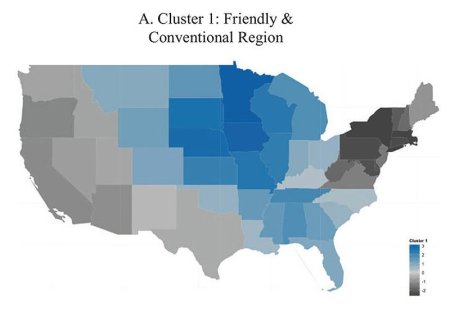
The “friendly and conventional” (FC) region in the middle and southern part of the country is characterized as being more extraverted, agreeable and conscientious, a little more emotionally stable (low neuroticism), but also much less open to experience than the national average.
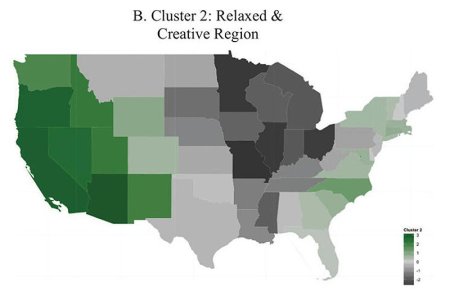
The “relaxed and creative” (RC) region in the western part of the country is characterized above all by being very open to experience and emotionally stable, but also introverted and slightly less agreeable than the average.
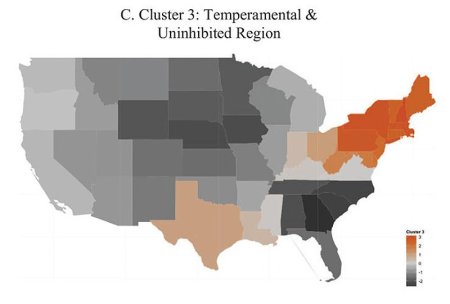
And finally, the third region, “temperamental and uninhibited” (TU), located in the northeastern part of the country, from Maine down to West Virginia, is characterized as very emotionally unstable and low in conscientiousness while being moderately introverted and open to experience. I wonder if that’s how they describe themselves on dating sites : )
I think most people can recognize that these differences exist to some degree. I’ve never been to America myself, but a friend of mine was there on a business trip and he noted how friendly and pleasant the Midwesterners were. But when he mentioned that he was heading to California they shook their heads and one of them said, “you won’t like it, it’s all Mickey Mouse.” But how much of this can be validated by society level measures?
The PESH – Political, Economic, Social and Health – Correlates
Rentfrow & Co used a variety of so-called PESH variables, and some general demographic variables. They then calculated correlations between them and state prototypicality, that is to say the measure of how well a state fits the personality profile of its region. And here is what they came up with,
| PESH | Friendly & Conventional | Relaxed & Creative | Temperamental & Uninhibited |
| Women | -0.22 | -0.16 | 0.39* |
| Non-Whites | -0.26t | 0.52* | -0.10 |
| Median Age | -0.18 | -0.17 | 0.44* |
| Votes Republican | 0.50* | -0.35* | -0.42* |
| Mainline Protestant | 0.43* | -0.49* | -0.24* |
| Wealth | -0.42* | 0.35* | 0.28* |
| Human Capital | -0.50* | 0.47* | 0.26t |
| Innovation | -0.42* | 0.45* | 0.22 |
| Social Capital | 0.34* | -0.37* | -0.14 |
| Social Tolerance | -0.38* | 0.54* | 0.08 |
| Violent Crime | -0.17 | 0.24t | 0.01 |
| Residential Mobility | 0.12 | 0.27t | -0.38* |
| Well-being | -0.23* | 0.47* | -0.06 |
| Health Behavior | -0.46* | 0.56* | 0.15 |
The correlations marked with a * are at the 5 percent level and those marked “t” is at ten percent. As you can see the PESH variables in many ways show what we would expect from the personality profile of the regions. As the maps suggest, these regions are also fairly concentric – the geographical center is also the most prototypical part of the region and then states become gradually less so the further out from the center they are located. And given that the PESH correlations are based on prototypicality we would expect these variables to follow the same pattern. But we would expect wrong…
Things Fall Apart; the Center Cannot Hold
For instance, the FC region has the strongest positive correlation to political conservatism. This region has a core consisting of six states: Iowa, Minnesota, South Dakota, Nebraska, Missouri and Wisconsin. Rentfrow measured political conservatism as the tendency to vote Republican, by using a combination of percentages of votes for George W Bush in 2004 and John McCain in 2008. Now, I’m no statistician but if this measure correlates 0.50* to how typical a state is of the FC region I would think the most typical states would be the most Republican and then gradually less so in a concentric fashion. But looking at the results (in the link above) for 2008 we find that Obama actually won three core states – Iowa, Wisconsin and Minnesota. And the rest of the core states were not nearly as big victories for McCain as they were in the more remote and less typical states in the South.
It’s also worth mentioning that voting results are most likely affected by the personal style and charisma of the candidates as well as specific issues that may be important in one election and region but not the other. Gallup measure of political conservatism (and liberalism) more directly by simply asking people. In the core states 36.2-42.9 percent identify as politically conservative, which is slightly above the national average of 36.9. And again the southern states that fit the profile less well score much higher, with an interval of 41.8-47.9 percent. So again, we find the same reversed pattern where the PESH variable is the strongest in the states that are less typical of the region.
Same thing with religiousness, which was measured with mainline Protestant affiliation, a rather narrow measure the source of which I haven’t been able to retrieve. But since Gallup also tracks Protestant affiliation it should make a fairly good substitute. Again, it turns out we have a weak center and a strong periphery: the six core states have an average of 55.5 percent Protestants while the southern states average at 75.2 percent. No overlap between the core and peripheral states.
Further, the economic wealth measure is a composite which I can’t reconstruct because they don’t explain how it’s defined, but it’s based on things like GRP, median household income per capita, poverty rates etc. With a correlation between this wealth measure and state prototypicality of -0.42* the implication is that the FC region is poor. I didn’t find median household per capita but I looked at the similar measure per capita income for the same year (2007). While the six core states were slightly below the national average we again find that the southern states are way lower, again with no overlap between the richest southern state and the poorest core state. Or we can look at poverty rates, here from 2008 which is around the same time Rentfrows data are from,
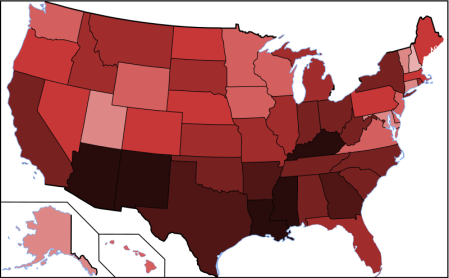
As you can see, it’s the same thing again: the core states have fairly little poverty but the less typical southern states have plenty. Yet again, there is no overlap.
A Flyover Bias?
Whether intentional or not, I find this highly misleading. I’m not sure what makes Rentfrow do this but I have a suspicion it may be a liberal bias against the “flyover states.” This bias can be seen when comedian/pundit Bill Maher recently interviewed actor Bruce Dern and dismissed Nebraska as old and poor. As I’ve shown in a previous post, Nebraska is not at all poor – unlike California which has the highest poverty rate in the country – and its median age, according to US Census 2010, is 36.2 years, one year higher than that of California but still below the national average. Since some 95 percent of personality and social psychologists are liberal and plenty admit to a rather hostile bias against conservatives, this shouldn’t come as a big surprise.
The Real FC Region: The Friendly Midwest
But let’s not throw out the baby with the bathwater. If we restrict this region to only the most typical states, the core, then we have something that looks homogeneous and concentric in terms of both personality, geography and society level correlates. They are east Midwesterners, they are indeed friendly and conventional, but in contrast to what the study suggested, they don’t stand out in any conspicuous way. They are moderately conservative and religious, they earn slightly less money than the average but they also have slightly less poverty and crime. And that’s pretty much what you’d expect from friendly and conventional people.
The RC Region: Creative and Relaxed, But Also Violent and Poor
It’s also easy to spot a similar but positive bias for the RC region. For instance, the correlation with violent crime is only slightly elevated at 0.24 at the ten percent level. But if we look at murder rates, we again see how peripheral and less typical states, like Idaho and Utah with really low murder rates, help keeping the region looking relatively peaceful. But of the most typical core states, California, Oregon, Nevada and Arizona, only Oregon is below average.
The correlation to wealth at 0.35* looks good and in line with what you might associate with a modern and open-minded region. As I mentioned above, the measure of wealth is complex and not explained in the article so again I looked at per capita income for 2007 (the year his index is based on) from the US Census. The core states are in the range 33K-41.6K dollars with an average of 37.5K, slightly below the national average of 38.6K, (although slightly above the FC core of 36K). The peripheral states have smaller incomes. I’ve already shown the poverty map above and that doesn’t help either. Somehow Rentfrow manages to make this region look wealthy but it seems to be an artifact of his calculations and perhaps wishful thinking.
The Real RC Region: The Left Coast
Again, this is not to say that the Relaxed & Creative region doesn’t exist, but like the FC region, it would become more homogeneous and meaningful if limited to a smaller area, in this case the coastal states. This is not just a matter of bias, but also how these calculations are made. I’m no statistician but Utah, although in the periphery is clearly marked on the map above as part of this region even though it is slightly above average in extraversion, agreeableness, conscientiousness while slightly lower in openness. It seems to fit this region by virtue of low neuroticism alone. And half the country is low in neuroticism. Have a look for yourselves at the eight main states of this region, traits listed in the order extraversion, agreeableness, conscientiousness, neuroticism and openness,
Oregon 30.9, 59.1, 45.8, 39.5, 58.8
Washington 30.6, 55.8, 45.0, 36.9, 56.6
California 51.4, 49.0, 43.2, 39.1, 65.0
Arizona 50.6, 46.6, 58.4, 38.1, 54.7
Nevada 46.4, 31.8, 55.8, 44.0, 61.3
New Mexico 32.4, 45.4, 58.5, 51.6, 62.0
Idaho 40.7, 52.9, 44.5, 44.2, 44.7
Utah 55.8, 69.4, 54.5, 30.4, 47.7
As you can see, Oregon and Washington are virtually identical, while California fits fairly well, even though the state is now just above average in extraversion, possibly due to migration. This would make a region of low to average extraversion, average to high agreeableness, low conscientiousness, low neuroticism and high openness. There may of course exist other personality regions with interesting correlates too, but right now I’m going with what Rentfrow generated. If we map the modified FC and RC regions along with the original TU region on a map of social and economic conservatism and liberalism created by statistician Andrew Gelman we see how these states stick together pretty good,
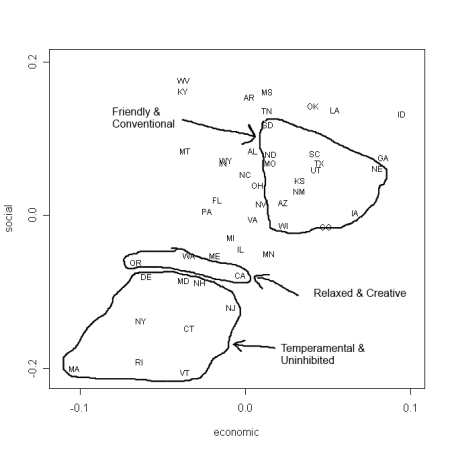
The Wicked Witch of the Northeast
When I saw how well this region fits into Gelman’s map I had a suspicion that Rentfrow got it right. But let’s check some correlates anyway. The biggest correlations are those of higher median age and a larger female population. This is fairly easy to check since this region is practically identical to what the US Census Bureau defines as the Northeast Region. The personality version of the region has a core area consisting of Pennsylvania and Delaware in the south and every state further north up to Maine. Peripheral and less typical states are Maryland, Ohio, West Virginia and the more remotely located state of Texas. According to the Census 2010, their Northeast Region has the highest median age (39.2 years) and the lowest sex ratio (94.5 men per 100 women). The average of the core states is 95.0 and for the peripheral states it is 96.1, so that looks nice and concentric. In case you wonder about the populous states of New York and Texas, I haven’t weighted anything but their averages are 93.8 and 98.4 so that would confirm the pattern even more. As for median age, it’s a similar picture with a core average of exactly 40 years while and a peripheral average of 37.9 years.
Finally, the last big correlate, political view, again I use Gallup’s record on how many identify as politically conservative rather than the presidential elections of 2004 and 2008 for the reasons I stated above. In the core states there is an average of 31.3 percent who think of themselves as politically conservative, well below the national average of 36.8, and equally important, below the average of 38.0 for the peripheral states.
Still, these correlates are pretty neutral. Violent crime is less flattering so maybe the zero correlation to this personality region is kept low by some tricky calculations as in the RC region? A quick look at the murder stats show that the core states have 3.9 murders per 100K people as compared to the periphery which has 4.7, identical to the national average. That’s the reverse of what we’d expect but it’s only one metric that varies over time so all in all, this region looks like it makes some sense. And there is no suspicion of bias.
All in All, a Brave Effort
While I’ve been whining a lot about the liberal bias in this study, I still think this is a bold step in the right direction. After all, all behavioral traits are highly heritable so research about these regions and their behavioral correlates can only be described as human biodiversity research. And we don’t see too much of that, unless it’s unintentional. It would have been nice if Rentfrow had shown how racial/ethnic groups differ since most of the samples had that information. Such differences could explain, at least to some degree, why we have these regions. When you see the high levels of neuroticism in the Northeast, it’s hard not to think of the Irish who are plenty in that region. It would also have been great if they had measured dark traits too – I mean, this is America we are talking about : )
But I’ll get back to the issue on how these regions came to be in a later post. Right now I just wanted to introduce them – and of course to show what they really look like : )



 Posted by Staffan
Posted by Staffan 
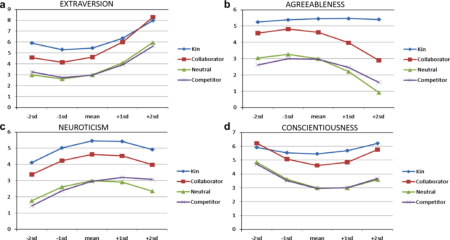















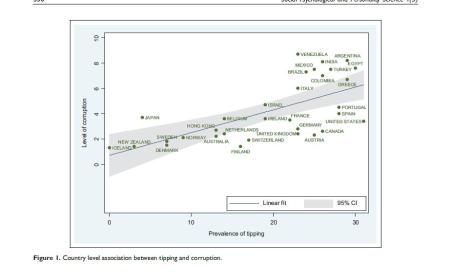 Magnus Thor Torfason, professor of Harvard Business School, and colleagues have made an interesting study on tipping and corruption, published in the journal
Magnus Thor Torfason, professor of Harvard Business School, and colleagues have made an interesting study on tipping and corruption, published in the journal 







